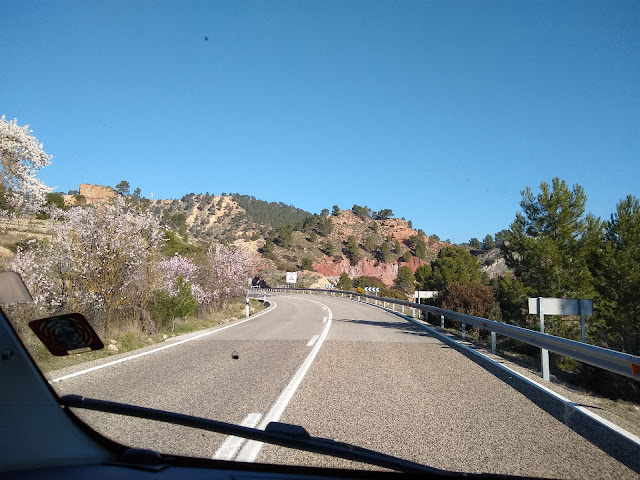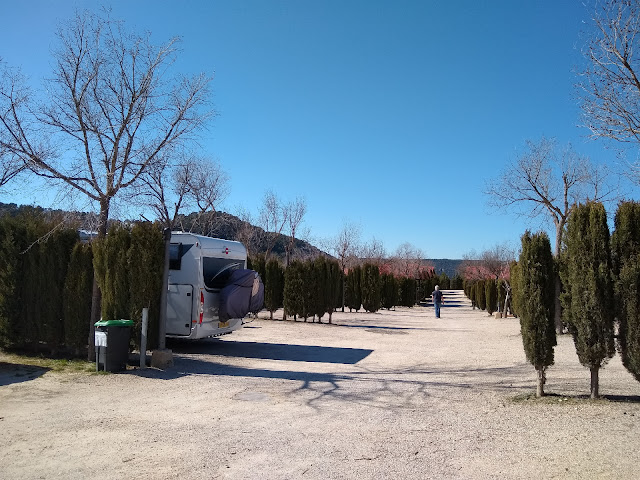Driving north on the N330, as you drop down from the flank of Sierra del Boquerôn towards the confluence of the Rio Júcar and Rui Xúquer two images drift through the windscreen in quick succession. The first is somewhat surprising given the hilly terrain and remote location - twin cooling towers belching steam into the pristine blue sky; the second as expected, the outline of Jalance's ruined castle, it was marked on the map, and anyway, for the past 80kms. every small town we had passed had been crowned by a crumbling Moorish fortress.
So next day, as we headed towards Utiel, we ignored the ancient monument and concentrated on the power station. Why was it here? There was no obvious local fuel supply like a coal mine. Neither was there a railway, and the twisting mountain road seemed blatantly unsuitable for the bulk transport of coal or oil. Our conclusion, the plant had to be nuclear powered. Later a Google search proved our hunch correct. Spain has five active nuclear plants and one of them was right there in the nearby village of Cofrentes .
Over the last week or so we have been watching 'Chenobyl'. The series is horrifying and thought provoking in equal measure. We finished watching the intense final episode just a couple of hours after wandering around Jalance, a place that seemed the epitomise the phrase 'haunt of ancient peace', but whose main employment turned out not to be olive farming but nuclear engineering. Given all the investment in wind and solar we wondered why Spain needed to persist with the 'nuclear option'. It didn't take a lot of googling to provide the answer.
In terms of greenhouse gas emissions nuclear power is less polluting than most renewable energy sources, and though Spain has only five nuclear power stations, they provide over 20% of the country's electricity. The plants are remarkably energy efficient. An average sized coal fired power station burns 3.3 million tonnes of coal in a year. A nuclear power station uses a mere 27 tonnes of enriched uranium to produce the same output.
It's easy to understand how the attitude to nuclear power over the past three decades has performed a 360° turnaround to become the 'non-renewable' of choice for a low carbon future. However no-one of our generation can feel entirely comfortable with that, we shivered in the Cold War's shadow, watched 'Ban the Bomb' marches morph into 'Non Nucléaire' ones and remember Chernobyl and Three Mile Island for real.
I read a couple of articles to find out if there had been much progress towards solving the problems of storing spent nuclear fuel since I was a member of Greenpeace forty years ago, and received regular updates on the various doomsday scenarios regarding Sellafield. The answer was no, we are still stockpiling radioactive material above ground in re-inforced concrete warehouses because it's too controversial to bury the stuff underground in a 'geologically stable' site, mainly because no-one is willing for their local lump of granite to be the chosen location.
To watch the finale of Chernobyl parked within sight of a nuclear power station could be dismissed as a coincidence, then the BBC ran a piece next morning reporting that Rolls Royce (of aero engine fame not her majesty's limos) are developing off the peg mini-reactors to meet the expected spike in power generation when we all start driving electric cars - now all this radioactive information overload felt like deliberate gas-lighting. Matters nuclear preoccupied the in-cab conversation until we reached the spectacular hills of the Serra Martes. Then we stopped worrying about a future we can't influence nor live to see and marvelled at the here and now instead.
At Requena we joined the A3 motorway . It connects Madrid and Valencia, our destination was 40kms westwards on the border of Communidad de Valenciana and Castille la Mancha. The last time we were here at the Kiko Park campsite we accidentally arrived on Valencia national day. It was like walking inadvertently into a fiesta; family celebrations around big flaming braziers beside each pitch carried on for half the night. Today could not have been more different. It seemed we were the only guests in the place. The last time we had an entire site to ourselves was in Greece, it feels a tad un-nerving for some reason..
The site epitomises Rebecca Solnit's notion of a 'Faraway Nearby'. The motorway is no more than a couple of kilometres away, the high speed train line even closer, the nearby wine village of Villargordo del Cabriel out of sight over the brow of the steep hill down to the site. Despite nestling in the midst of a man-made environment - the lake Kiko Park overlooks is a giant reservoir - somehow it all feels somewhat remote, a big scrap of wilderness, an escape from the micro-managed world we we habitually inhabit.
I needed an escape from it. The last couple of weeks of winter sun on the Costas had been a tad demoralising: the sunshine, lovely, the sprawl less so.
Kiko Park is a big site based around a cluster of old buildings which look as if they were once the centre of an extensive wine or olive estate. I suppose its 'coto' was drowned by the embalse. In the summer there is quite a lot to do, kayaking, sailboarding and paddle boarding on the lake, canyoning down waterfalls, Nordic walking through the rough terrain. At this time of year, though the site restaurant is open, there is little else to do other than stare at the lake or take a walk down on of the stony tracks that lead off from the site. It was warm enough in the early evening to cook outside. That suited us fine, we don't need to be entertained.
There is something otherworldly about these big Spanish resevoirs that flood the Sierras' deep valleys. They look distinctly unnatural, nonethless the spurs of raw earth jutting out into the deep blue water have a kind of abstract beauty that draws the eye.
The uncultivated garrigue on their steep slopes is covered in flowering shrubs and herbs. It's simply a very satisfying landscape to loiter in.
Later on Friday a couple of other vans turned up - British and German - it was good to have a bit of company. One thing you can be sure about on a Spanish campsite, just because it is remote does not mean it will be peaceful. Friday afternoon was accompanied by the sound of hedge trimming man chopping the tops of the pitches' conifers. He packed up at 5.00pm on the dot just as the invasion of Spanish weekenders arrived. As it was mid-February there were only a handful of them, but in no way did this ensure tranquility, it is truly remarkable just how raucous a small gaggle of socialising Spanish can be. However, it is a happy cacophony and we can live with that.
The top prize for mayhem has to be shared. The site's teens and tweenies deserve a special mention. From sunset until late they occupied the laundry and washing-up sink areas as informal hangouts, the laundry becoming a speed dating event for the 14 plus. That was ok, as on the whole grown-ups don't do their laundry in the dark.
The tweeny girls had gathered in the washing-up area, this was a little more problematic. Half a dozen or so of them had purloined a washing-up sink each; they slumped in them with their legs dangling over the edge, communicating to each other by phone, every so often screaming with laughter, presumably at the latest Tik Tok sensation. There was one sink still available for pot washing, the kids and I carried on as if neither of us had noticed the other. However their fun came to a sudden end when a Spanish woman turned up with a pile of dishes. A quick burst staccato Castillian and the youth club moved on, summoning up a laconic demeanor designed to exude the impression they had been about to leave anyway. The effect of their theatrics was somewhat undermined when you noted each of them sported an identical circular wet patch on their bum; that's what happens if you decide it's cool to sit in a sink.
Next day was Sunday. Experience has shown us this is going to be the most lively time on any Spanish site as the focal point of any weekend away is the big family Sunday lunch. This particular Sunday was further enlivened by the bunch of twenty somethings two rows across from us who decided that what we all needed was a rock soundtrack to brighten the sunny weekend. At first we thought it was Madrid's finest rock station, then concluded from the similarity of the tracks it was a genre based Spotify playlist and the occasional speech between tracks were adverts. The chosen genre was definitely un-Hispanic, most tracks sounded like Green Day sung in Spanish, definitely a punk vibe. We dubbed the genre 'Spunk'.
None of the mayhem is actually 'disquieting', because if you want a bit of true Brit peace and quiet then you just take a stroll. Within 200 metres you feel you are in the middle of nowhere, even though you are not.
The same goes for the Madrid to Valencia high speed train line which is less than half a kilometre from the campsite. It proved less disturbing than we feared. Only a short length of the track between two tunnels is actually visible and most of that is in a cutting.
.
Also the trains are infrequent, two an hour on average. The above ground whoosh is very short-lived as they are travelling at a 180mph. On the day we arrived one rocketed up the line as we returned from a walk. I glanced at my phone, two minutes past five, I decided to come back the following day to take a photo, after all it's going to be almost a decade before we can do the same thing in the UK. However, when I returned on Saturday at the same time no train materialised. I was about to cast aspersions on the punctuality of Spanish railways when it struck me that the weekend timetable was probably different.
Once I get an idea in my head I can't shift it. So on Sunday we took a stroll up the rough track that ran parallel to the line for two or three kilometres between the two tunnels. I figured at least one train must pass during our walk, and it did.
It might be a super-geeky thing to do - a short stroll alongside a high speed train line, which it was, looking to the left there was little to appreciate other than the finer points of Iberian railway engineering.
However to our right was a hillside covered in olives with almonds trees dotted among them. Dark green olives mixed with white almond blossom, a truly lovely thing that lifts the spirits.
We decided we liked Kiko Park's 'humanised wilderness', and had been lucky to be gifted three days of calm weather, blue skies and warm sunshine during the day with a clear view of the Milky Way after dark. We know in two weeks time we will return to a Pennine winter, so out came our stock phrases, "We can't do this in Buxton! Have you seen the weather at home..."



















No comments:
Post a Comment